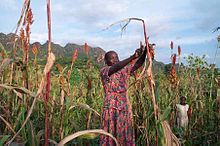This article relies largely or entirely on a single source. (August 2008) |

Agriculture in Sudan plays an important role in that country's economy. Agriculture and livestock raising are the main sources of livelihood for most of the Sudanese population.[1] It was estimated that, as of 2011, 80 percent of the labor force were employed in that sector, including 84 percent of the women and 64 percent of the men.[1]
Agricultural products regularly accounted for about 80 to 95 percent of exports until the oil industry came on line.[1] Total sector activities contributed an estimated 35.5 percent of GDP in 2006, a decline from the years prior to the development of the oil industry.[1] Crop cultivation was divided between a market-oriented sector comprising mechanized, large-scale irrigated and rain-fed farming (mainly in central Sudan) and small-scale farming following traditional practices carried out in parts of the country where rainfall or other water sources were sufficient for cultivation.[1]
Large investments occurred over time in mechanized, irrigated, and rain-fed agriculture, which together accounted for roughly two-thirds of Sudan’s cultivated land.[1] The early emphasis on growing cotton on irrigated land decreased.[1] Peanuts, wheat, and sugarcane are major crops, and considerable quantities of sesame also are grown.[2] Rain-fed mechanized fanning continues to produce mostly sorghum, but the cultivation of sesame has increased, and short-fiber cotton is also grown.[3] Production in both subsectors increased domestic supplies and export potential.[3] This gain appeared, however, to have been achieved mainly by expanding the cultivated area rather than by increasing productivity.[3]
Most subsistence cultivators produced sorghum as their staple crop, although in the northerly rain-fed cultivated areas millet was the principal staple.[3] Subsistence farmers also grew peanuts and sesame.[3] Following food shortages in 2001, there was an attempt to increase land area for the production of food.[3] The increase in food production, however, was at the expense of the production of export crops, although export crops increased in 2004 and the export of sesame and cotton continued to increase through 2008.[3]
© MMXXIII Rich X Search. We shall prevail. All rights reserved. Rich X Search
